The Mercedes C‑Class facelift is poised for a formal introduction, targeting enhancements in design, technology, performance, and safety. Following the evolutionary path from the W204 to the W206, this update reinforces Mercedes’ position within the luxury sedan segment.
Underpinning this facelift are recent industry advancements such as EQ Boost mild hybrid systems, updated AMGs, and enhanced digital interfaces. The goal is to create a refreshed C‑Class that appeals equally to loyal buyers and newcomers drawn by improved value and sophistication.
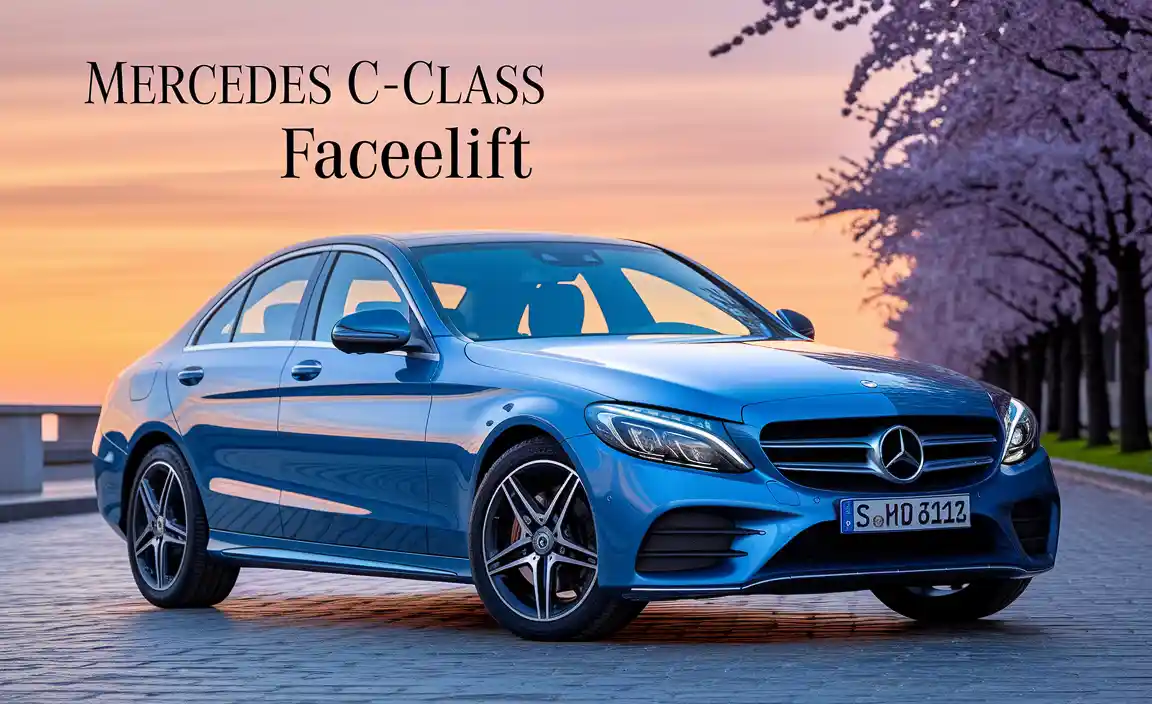
Overview Of Mercedes C‑Class Generations
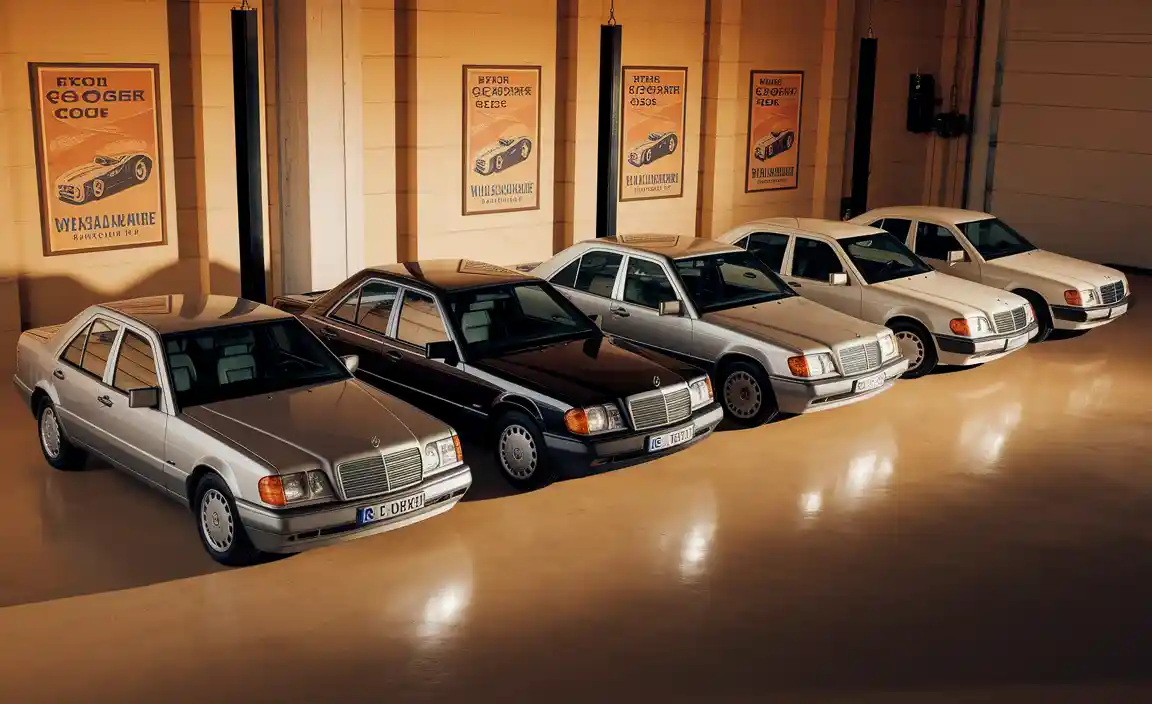
W204 (3rd Generation)
Launched in 2007, the W204 significantly influenced Mercedes Benz cars, setting a new standard in the compact executive class. Compared to BMW 3 Series and Audi A4, it emphasized a balance of comfort and performance. It introduced more rigid chassis dynamics and an emphasis on rear seat safety and comfort. Interior fittings became more luxurious, and early infotainment systems appeared.
While the W204 did not yet offer mild hybrid systems or large touchscreens, it established a foundation in build quality and brand identity that continues into modern facelifts.
W205 (4th Generation)
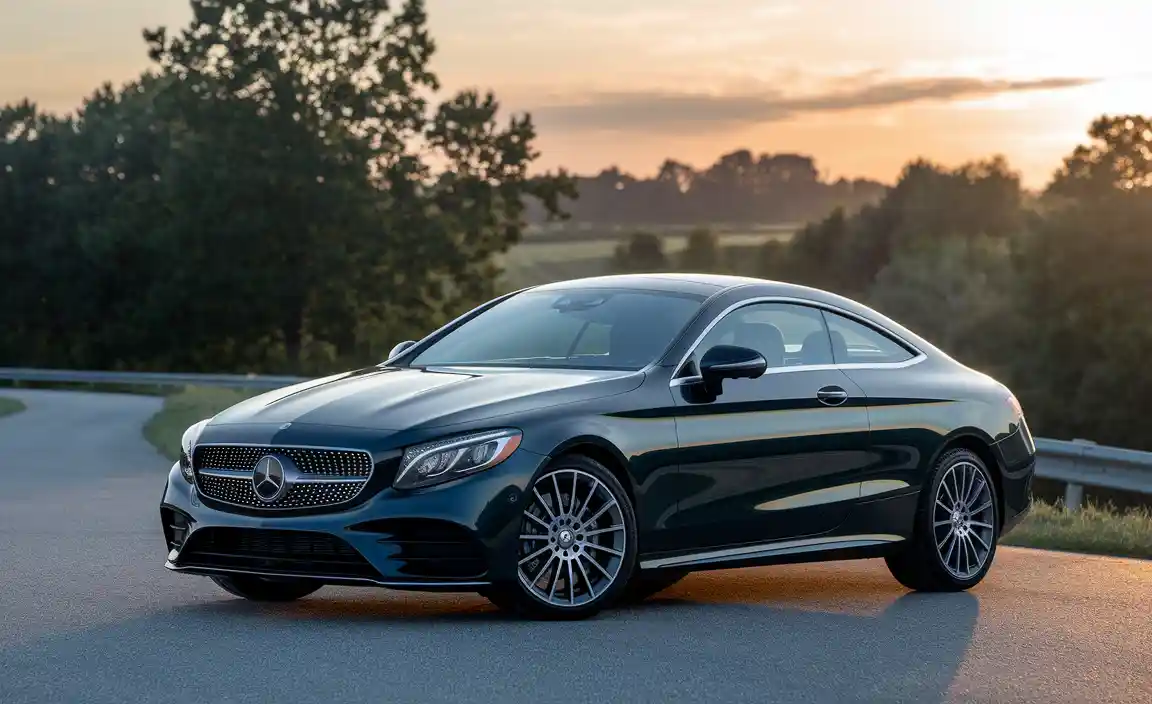
The W205 premiered in 2014, introducing enhanced digital features and improved cabin ergonomics. Material quality and fit‑and‑finish grew noticeably more refined. The interior saw a wider touchscreen infotainment system and digital instrument cluster.
Diesel models such as the C 300d and C 250d offered enhanced torque and refinement. Active safety systems and adaptive cruise control debuted or advanced. The W205 maintained its position against the BMW 3 Series and Audi A4 by combining comfort, digital sophistication, and fuel efficiency.
W206 (5th Generation)
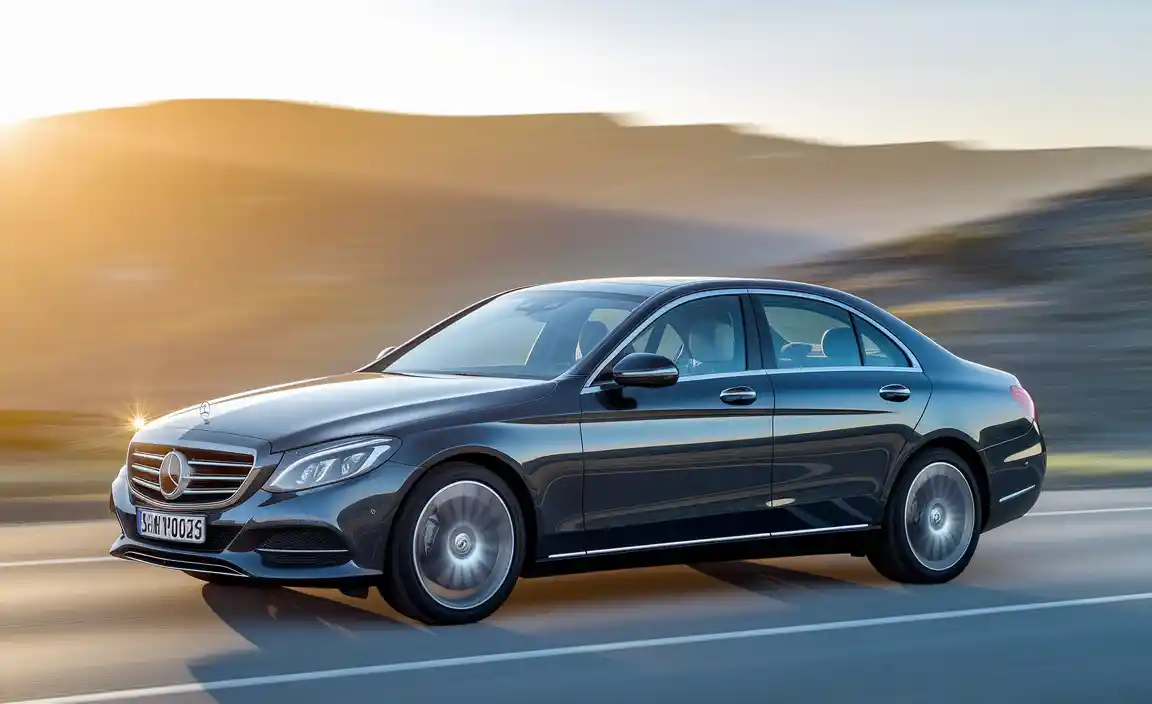
The current W206, introduced around 2021, pushed digital integration further. A central 11.9″ touchscreen is standard, while EQ Boost mild hybrid architecture provides smoother torque delivery and improved fuel economy.
AMGs—especially the AMG C63—introduced higher performance, air suspension, and maximum power exceeding 500 hp. This generation underscores Mercedes’ investment in intelligent architecture. The facelift builds upon this, refining existing technologies and introducing new features in driver assistance, interior luxury, and design.
Evolution Of Aesthetic Appeal
Exterior Design Changes
Each C‑Class facelift has featured the refined integration of refined design cues. The upcoming facelifted C‑Class introduces a redesigned grille, larger three‑pointed star, and sleeker LED units. Bumper profiles have been sharpened to evoke AMG models without overstating sportiness.
Side creases and fender arches subtly accentuate wheel stance. Rear-end updates include revised light signatures and integrated diffuser elements. Overall, the refreshed C‑Class balances a bold front fascia with elegant rear styling that complements Mercedes’ wider model range.
Interior Design Enhancements
This update enriches cabin ambiance through enhanced materials and design revisions. Dash trim now includes higher-grade aluminum or open-pore wood options. A reconfigured center console incorporates haptic buttons and ergonomic placement. The updated instrument cluster features more customizable layouts, crisp graphics, and seamless integration of driving data.
Ambient lighting zones have been expanded to include door panels and footwells. The enlarged rear seat footwells, improved cushioning, and optional heated seats add comfort for rear-seat passengers. Overall, the facelift introduces both refined touches and substantial improvements.
Technological Sophistication Across Generations
Infotainment System Developments
The facelift elevates MBUX functionality further with improved processing speed, sharper resolution screens, and more intuitive voice commands. Gesture control enhancements and predictive AI for navigation and route planning enhance user convenience. Wireless connectivity (Apple CarPlay/Android Auto) is fully integrated, with expanded support for over-the-air software updates.
Optional feature packages may include AR navigation overlays, multi-user profiles, and personalized ambient lighting presets. Infotainment now extends beyond entertainment, becoming a central pillar in personalized, connected driving experience.
Safety Technology Advancements
Mercedes continues to enhance safety through upgraded sensors and artificial intelligence. The facelifted model may include improved radar and lidar systems, enabling better predictive lane centering, automatic emergency braking, and intersection assistance. Blind spot detection and rear cross-traffic can be expected to operate more seamlessly. Adaptive cruise control may offer smoother stop-and-go functionality.
New driver alertness monitoring systems, along with interior cameras, may determine drowsiness. The cumulative effect enhances Level 2+ autonomous capabilities, reducing driver fatigue and bolstering safety.
Driver Assistance Features
Advanced driver-assistance systems (ADAS) will be more intelligent, with improved lane-keeping, active emergency steering, and hands-free highway driving assistance. Enhanced sensor fusion enables more reliable operation, even under poor weather conditions.
Parking assistance will include upgraded 360-degree cameras with a clearer bird’s-eye view and automated exit maneuvers. Traffic sign recognition and new ‘no-passing’ zone braking may be present. Collectively, these features underscore Mercedes’ strategy of combining luxury with cutting-edge safety technology.
Performance Enhancements
Engine And Powertrain Improvements
The facelift incorporates targeted engine refinements for smoother power delivery and efficiency. Diesel variants such as the C 300d and C 250d receive improved torque curves and lower emissions. Petrol and mild-hybrid models—such as entry-level C‑Class with EQ Boost—gain re-tuned transmission shifts and finer throttle response.
High-performance AMG variants may benefit from enhanced intercooling, weight-saving measures, and increased peak power outputs. Subtle mechanical adjustments yield improved refinement and responsiveness.
Suspension And Handling Updates
The facelift enhances ride dynamics with revised air suspension calibration and revised damping systems. Comfort remains a priority in casual driving, while sharper responses are activated under Sport and Sport+ modes.
AMG variants may include bespoke adaptive suspension, lowered ride height, and stiffer anti-roll bars for improved cornering stability. These mechanical changes improve body control and reduce understeer, aligning ride comfort with sportiness without sacrificing daily usability.
Impact Of Facelifts On Market Position
Competitive Analysis
The facelifted C‑Class competes directly with BMW 3 Series, Audi A4, and Audi RS5. It offers superior interior digital quality and comfort, matched by rival performance in power and handling.
Against electric sedan rivals, the move toward mild hybrid and future electric variants is essential. At launch, pricing will need to remain competitive to offset premium for updated features. Mercedes’ brand cache and heritage provide an edge in maintaining strong market presence.
Consumer Feedback And Reception
Early previews suggest positive reception to subtle design changes, upgraded tech, and enhanced safety. Initial reviews consistently highlight cabin quality, ride refinement, and newly introduced driver assistance features.
Social media commentary suggests high interest for hybrid options and improved rear seat comfort. Analysts project incremental sales growth post-facelift as dealers update inventory and marketing campaigns target both new buyers and those in lease renewals.
The Future Of Mercedes C‑Class
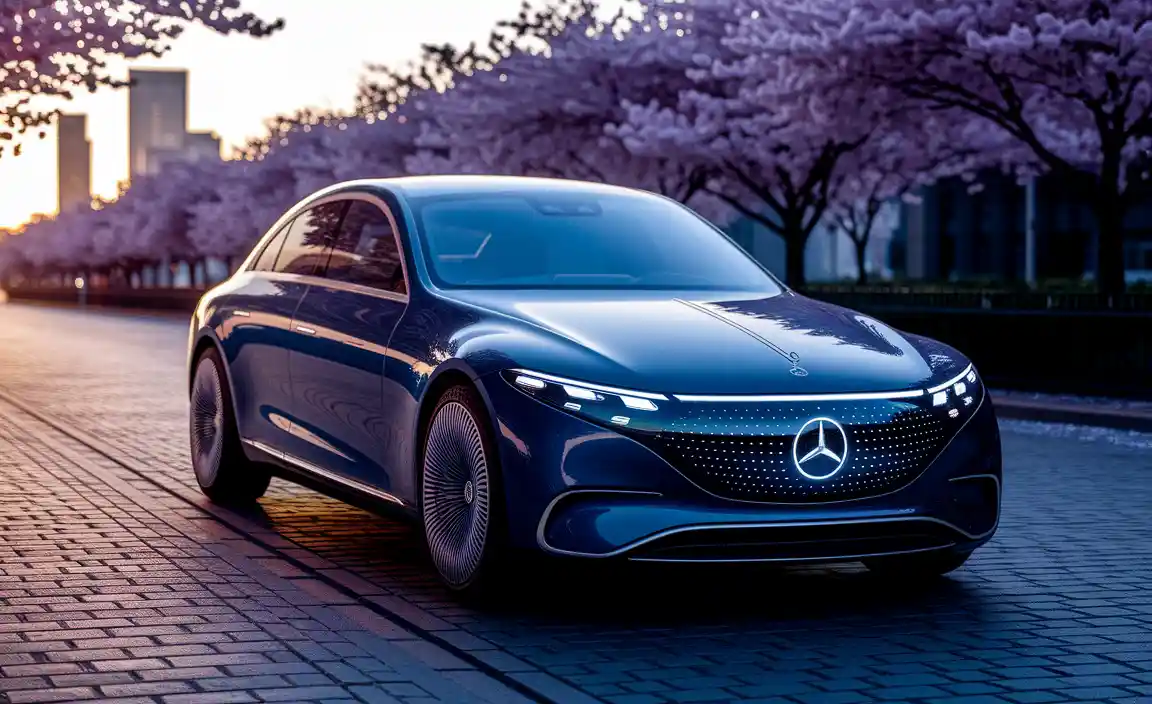
Anticipated Trends And Innovations
Looking ahead, Mercedes will likely introduce a plug-in hybrid or fully electric C‑Class under the EQ sub-brand. Digital features will continue evolving with AI assistance—context aware suggestions, in-car virtual assistants, and biometric customization.
Additional ADAS capabilities may expand into Level 3 autonomy when regulations allow. Materials may become partially recyclable, aligning with sustainability goals. Expect increased personalization via digital profiles, modular interior trims, and optional rear seat entertainment systems.
Influence On The Luxury Sedan Market
The facelifted C‑Class will set a precedent for mid-cycle refreshes in the premium compact sedan class. With its interior tech, mild hybrid performance, and updated safety, it resets expectations. Competitors will need to enhance cabin aesthetics, integrate hybrid systems, and improve autonomous capabilities. The refreshed C‑Class will likely become the benchmark for ride comfort and intelligent features within its segment.
Competitive Deep Dive
- BMW 3 Series: Stronger on handling, though C‑Class offers superior comfort and tech.
- Audi A4: Comparable styling and interior luxury; Mercedes edges ahead in ambient tech.
- Audi RS5: High-performance alternative, yet lighter on luxury and ride refinement.
- S‑Class: Larger sibling with more grandeur, but C‑Class offers tech trickle-down at a smaller size.
Merits of the facelift include slight weight reduction, better in-car experience, and refined aesthetics without major redesign costs. Rival manufacturers may respond with cabin refresh and hybrid variants to maintain competitiveness.
AMG And Sport Models
Amg Models Like C 63

Well, the AMG versions will feature enhanced bodywork, upgraded air suspension tuning, and refined power output. The facelift may include revised exhaust geometry to optimize flow and sound, and carbon-ceramic brakes for improved fade resistance.
Exterior cues such as wider fenders, radial air intakes, side skirts, and rear diffusers will distinguish AMG C‑Class models. Interior enhancements—sport seats, trim inserts unique to AMG—preserve the performance aura.
Rivalry With Performance Sedans
In the face of BMW M3 and Audi RS5, the AMG C‑Class will rely on its balanced combination of torque, styling, and comfort. Peak torque figures (now quantified) will remain critical to competitive edge. Weight reduction and mechanical changes in suspension topology ensure sharper responsiveness. These measures support Mercedes’ aim to retain or exceed segment benchmarks.
Facelift Details That Matter
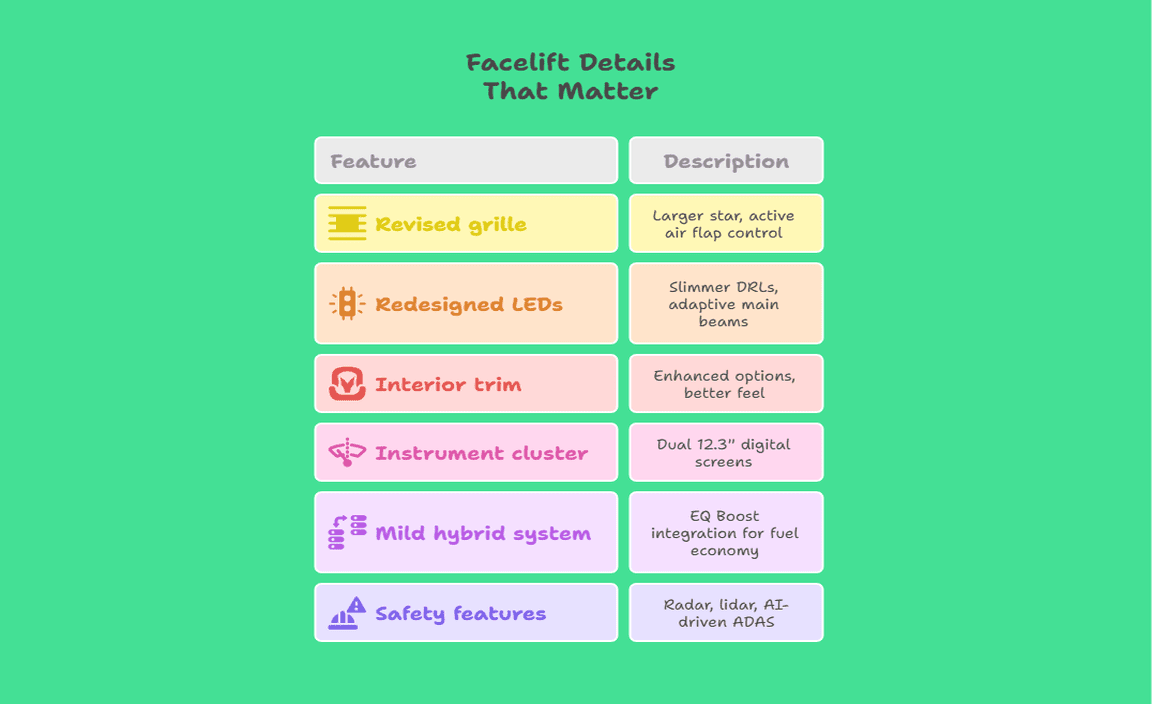
- Revised grille: Larger star with active air flap control.
- Redesigned LED units: Slimmer daytime running lights, adaptive main beams.
- Interior trim: Enhanced options, better feel at touchpoints.
- Instrument cluster: Dual 12.3″ digital screens with configurable layouts.
- Mild hybrid system: EQ Boost integration in many models for fuel economy.
- Safety features: Radar, lidar, and AI-driven ADAS for semi-autonomous driving logic.
These changes contribute to refreshed Mercedes C‑Class image and maintain technical positioning against emerging competitors like electric sedans.
Market Impact & Consumer Reception
Early Reviews
Automotive press highlights modernization without overhauling brand identity. Tech upgrades, AMG refinement, and improved rear seat comfort receive praise. Some reviews identify ECU tuning and increased torque as real-world benefits.
Buyer Trends
Sales forecasts expect facelifted models to account for 25–30% more monthly registrations due to updated features and appearance. Inventory transitions typically peak shortly before product launches. Fleet adoption may increase if efficiency gains are confirmed.
The Future Outlook
Electric C‑Class Launch
Anticipated for late 2026, the EQ‑branded electric C‑Class promises 300–350 miles of range, high-voltage architecture, and dual motors. Digital dashboards and ADAS expected to platform-share with electric S‑Class and G‑Class EQ models.
Enhanced Hybrid Lineup
Mild-hybrid and full-hybrid C‑Class variants will see expanded footprint. More powertrain combinations, e.g. C 300d with integrated starter generator, bridging diesel efficiency and hybrid assistance.
Influence On Mercedes Model Range
The facelift’s technology—dials, screen layouts, ADAS software—will flow into smaller Mercedes compact models and SUVs. Future G‑Class and S‑Class models may see aesthetic cues or software adaptations first trialed on the C‑Class. Overall, it acts as a tech incubator for brand-wide rollouts.
Conclusion
The Mercedes C‑Class facelift reinforces Mercedes’ commitment to evolutionary innovation. Through refined design, expanded driver assistance, mild-hybrid tech, and enriched interior quality, it sharpens its edge in the compact luxury sedan category.
With rising competition from electrified models and rival sedans, this refresh ensures the C‑Class remains relevant, compelling, and capable. Buyers benefit from updated aesthetics, improved comfort, enhanced safety, and better fuel efficiency—all without a full redesign.
Frequently Asked Questions
1.When Will The Facelifted C‑Class Be Available?
Mercedes typically debuts at major auto shows. Speculation points to a Geneva Motor Show rollout in 2025, with dealership availability late 2025 or early 2026.
2.Will The Facelift Include An Electric Variant?
Not immediately. However, the facelift positions the C‑Class for future integration into the EQ electric family, expected after 2026.
3.What Changes Can Buyers Expect In Driver Assistance?
A: Expect enhanced lane-keeping, adaptive cruise, automated braking, intersection assist, and improved semi-autonomous highway driving logic aligned with Level 2+ standards.
4.How Will The Facelift Affect Fuel Economy?
Mild hybrid EQ Boost systems improve fuel efficiency by up to 10% compared to the current model. Improved aerodynamics and software calibrations also contribute.
5.Are AMG Models Included In The Facelift?
Yes. AMG variants, including the AMG C 63, will feature subtle body tweaks, improved air suspension tuning, and increased performance specifications.